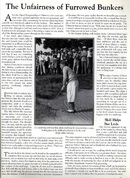They're moaning and groaning about the groovy bunkers at Muirfield Village. From what I saw on television, the bunkers looked about the way bunkers used to look, oh, 15 years ago when they were dragged careless with a sand pro.
Granted, furrowing is contrived, and this nonsense about going in a certain direction is brutal, but gosh, it didn't exactly look like the Oakmont silliness. Yet...
Mark Lamport Stokes reports that both Nick Price and Ernie Els are not fans.
"I heard someone say earlier in the week that this is the way that they used to rake bunkers way back when and bunkers have always been hazards," the Zimbabwean said after carding a 69.
"I think the difference now is that the greens are running at 13 or 14 (in putting speed). Back in the bygone era, when they did it before, the greens were probably running at about six.
"It's different hitting out of a bunker to a green where you've got no chance to get any spin on the ball. So I disagree with it. I don't like it at all.
"I don't think there's one player out here that does. It's a bit of pot luck, to be honest.
"You can get in there and have a perfect lie when it lands on top of a groove, then you can have another one that goes in the trough, in the bottom of it, and you've got no chance."
Uh, they used to call that Rub of the Green. I know, I know...in his defense, I would add that there also wasn't as much rough on steroids as there used to be. If you read The Future of Golf, you know I argued that if bunkers were to ever get nasty again (preferably through no more maintenance crew raking after Wednesday play), it would also require getting rid of some of the long grass to at least feel more equitable.
Anyway, Els...
"You're either lucky or unlucky," the South African world number six said after three bogeys in the last four holes gave him a first-round 74. "If you're unlucky, you have no shot, basically.
"I don't care how good of a bunker player you are, you have no shot. But I guess that's what they want."
Sean O'Hair had a different take...
"A trap is a trap, it's a hazard," said O'Hair. "You're not supposed to be there.
"The bunkers here are not hidden, you know where they are. So don't hit it there. If you don't hit it there, you don't have to worry about it."
In this AP story, Jeff Maggert, a well known expert on bunker raking who likely will find himself in the USGA's $#@!* pairing in two weeks, was quoted:
Jeff Maggert suggested that if Nicklaus wanted to make the course harder, he should have narrowed the fairways. As it was, Maggert said, "to try to kind of manufacture something is Mickey Mouse."
And Robert Allenby wasn't a fan either, though I'm not convinced by his argument either:
This is the best-groomed golf course, and I can't believe they would do the bunkers like this," Robert Allenby said after a 71. "It already was hard to get the ball tight. I don't think anyone likes it who is playing this tournament."
Nicklaus said that the new rakes and method of raking was a trial run for other stops on the PGA Tour.
"I don't believe that," said Brad Faxon, who had a 73. "I just don't think these bunkers were that easy to begin with, you know? I don't mind, because I'm a good bunker player. So it wouldn't bother me, but I don't think this place is broken, either."
And if you're a Nick Price fan, this is just painful to read...
"It's kind of a waste, because he [Nicklaus] has such beautiful sand in the bunkers," Price said. "Why put beautiful sand in the bunkers if you're going to rake them with these rakes? You might as well put crappy sand in there."
 Noticed this in the table of contents for July's Golf Digest:
Noticed this in the table of contents for July's Golf Digest:














